M&GN brake van
You are using an out of date browser. It may not display this or other websites correctly.
You should upgrade or use an alternative browser.
You should upgrade or use an alternative browser.
Liver & Fry's workbench
- Thread starter Liver & Fry
- Start date
Lyndhurstman
Western Thunderer
That looks lovely. A nice level of detail, I think. Did you glue the lamp irons on? I tried to drill some, but gave up. It's one aspect that I don't enjoy; the GNR one I did has a plethora of the things too!
Cheers
Jan
Cheers
Jan
Liver & Fry
Western Thunderer
That looks lovely. A nice level of detail, I think. Did you glue the lamp irons on? I tried to drill some, but gave up. It's one aspect that I don't enjoy; the GNR one I did has a plethora of the things too!
Cheers
Jan
Thank you!
These ones are glued on by virtue of the shape of the bracket. The drilling will come when I do all the handrails!
- James
Project Holme Hale - A story about blue potatoes
Liver & Fry
Western Thunderer
It probably seems like I've been a little quiet on the modelling front of late, but whilst current projects have taken a back seat, I have actually been working on something else that I didn't want to reveal until today. I've affectionately called it 'Project Holme Hale'.
So, for context, my Grandad was a farm labourer and I fondly remember how he used to tell stories of the things he got up to. About a month and a half ago, as my wrist was recovering, I got back out in the garden to tidy up the then neglected vegetable patch. This was another legacy of his and an influence he had on my life, but I digress. Whilst I was turning over the plot, I was reminiscing over his tales and how much I miss him, when I half remembered a story of him loading up wagons in the goods yard at Holme Hale, Norfolk. This would have been in the early-mid 1960s when the branch was in its final days. There was one key memory that stood out: "blue potatoes".
Yes, you read that right, blue potatoes. What I could remember was him saying that he used to load potatoes at Holme Hale, but that these were sprayed with a blue dye to deter people from eating them (although he'd then confess to swiping a few because "they still came up lovely once you scraped the skins off"!). After talking to my neighbour, he confirmed that this used to be a practice by which potatoes destined for cattle feed were sprayed blue to mark them as such (which reawakened another memory of Grandad saying that the cattle that did eat them would have blue drool because of the dye).
So, where am I going with this? Well, I figured that, whilst Grandad was not in any way a railway man (his interest was always farming), me recreating that memory as a model would be my own way of remembrance to him.
I done some deep digging online and found reference to a modern practice of spoil marking with a blue dye based on E133 "Brilliant Blue" - E133 was authorised as a food colourant in the 1960s and so the time frame would fit its use in agriculture.
So, I had my shade of blue and my historical basis for the model. All that was left to acquire now was a wagon and an appropriate potato load. My initial search led me to discover Ten Commandments plaster based sugarbeet loads (which my Dad had commented was something else Grandad used to load into wagons). Hmmm. One wagon had now become three, as you get two sugarbeet loads per pack. I acquired three Bachmann 16T mineral wagons from a well known auction site and these were weathered accordingly. And what of the potatoes? Well, eventually I found a brand called Juweela, who make 1:45 scale potatoes (approx 2.5mm diameter per potato - large by '00' standards, but the best I'd get).
This is the result:

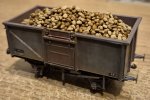
(Before painting blue)
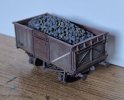
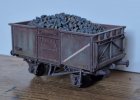
And the final result!
A strange thing to see, but one that is historically accurate! It almost seemed a shame to paint them, but I obviously have my reasons for doing so.
Here's how the sugarbeet wagons turned out:

So, I modelled some wagons in memory of my Grandad. Job done, right? Right...?
I looked up Holme Hale in Peter Paye's 'Branch lines to Thetford' and found this photo:

Uh-oh... Looks like I now have a loco and a new traffic flow to model if I want to represent the railway my Grandad would have interacted with.
Back to the auction site it was then! Starting with the two grain wagons, these were TOPS era wagons as purchased, so I renumbered them using Cambridge Custom Transfers and then weathered accordingly:

Finally, the 03. I acquired a model of a plain green 03 but realised upon arrival that it had the wrong chimney. It seems replacement flowerpot chimneys aren't something you can buy online, so I had to use my ingenuity. I cut the mid section of an old paint brush, drilled into the top and bottom, cut a small section of a cocktail stick to make a peg for the bottom and ran a ring of wire around the top for a lip. This was what I ended up with:
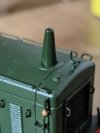
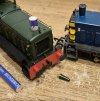
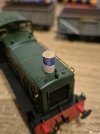
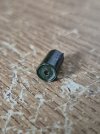
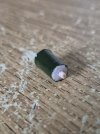

I then renumbered, lightly weathered and added both warning flashes and builders plates to get this final result:
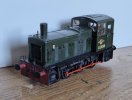

So there we have it! One sentimental tale about blue potatoes led to me modelling an entire freight train!

The only thing left to answer, is why did I have today as my deadline and date to reveal this side project? Well, today would have been Grandad's 92nd birthday and for that reason alone, it felt appropriate.
Happy birthday, Grandad x
- James
So, for context, my Grandad was a farm labourer and I fondly remember how he used to tell stories of the things he got up to. About a month and a half ago, as my wrist was recovering, I got back out in the garden to tidy up the then neglected vegetable patch. This was another legacy of his and an influence he had on my life, but I digress. Whilst I was turning over the plot, I was reminiscing over his tales and how much I miss him, when I half remembered a story of him loading up wagons in the goods yard at Holme Hale, Norfolk. This would have been in the early-mid 1960s when the branch was in its final days. There was one key memory that stood out: "blue potatoes".
Yes, you read that right, blue potatoes. What I could remember was him saying that he used to load potatoes at Holme Hale, but that these were sprayed with a blue dye to deter people from eating them (although he'd then confess to swiping a few because "they still came up lovely once you scraped the skins off"!). After talking to my neighbour, he confirmed that this used to be a practice by which potatoes destined for cattle feed were sprayed blue to mark them as such (which reawakened another memory of Grandad saying that the cattle that did eat them would have blue drool because of the dye).
So, where am I going with this? Well, I figured that, whilst Grandad was not in any way a railway man (his interest was always farming), me recreating that memory as a model would be my own way of remembrance to him.
I done some deep digging online and found reference to a modern practice of spoil marking with a blue dye based on E133 "Brilliant Blue" - E133 was authorised as a food colourant in the 1960s and so the time frame would fit its use in agriculture.
So, I had my shade of blue and my historical basis for the model. All that was left to acquire now was a wagon and an appropriate potato load. My initial search led me to discover Ten Commandments plaster based sugarbeet loads (which my Dad had commented was something else Grandad used to load into wagons). Hmmm. One wagon had now become three, as you get two sugarbeet loads per pack. I acquired three Bachmann 16T mineral wagons from a well known auction site and these were weathered accordingly. And what of the potatoes? Well, eventually I found a brand called Juweela, who make 1:45 scale potatoes (approx 2.5mm diameter per potato - large by '00' standards, but the best I'd get).
This is the result:


(Before painting blue)


And the final result!
A strange thing to see, but one that is historically accurate! It almost seemed a shame to paint them, but I obviously have my reasons for doing so.
Here's how the sugarbeet wagons turned out:

So, I modelled some wagons in memory of my Grandad. Job done, right? Right...?
I looked up Holme Hale in Peter Paye's 'Branch lines to Thetford' and found this photo:

Uh-oh... Looks like I now have a loco and a new traffic flow to model if I want to represent the railway my Grandad would have interacted with.
Back to the auction site it was then! Starting with the two grain wagons, these were TOPS era wagons as purchased, so I renumbered them using Cambridge Custom Transfers and then weathered accordingly:

Finally, the 03. I acquired a model of a plain green 03 but realised upon arrival that it had the wrong chimney. It seems replacement flowerpot chimneys aren't something you can buy online, so I had to use my ingenuity. I cut the mid section of an old paint brush, drilled into the top and bottom, cut a small section of a cocktail stick to make a peg for the bottom and ran a ring of wire around the top for a lip. This was what I ended up with:






I then renumbered, lightly weathered and added both warning flashes and builders plates to get this final result:


So there we have it! One sentimental tale about blue potatoes led to me modelling an entire freight train!

The only thing left to answer, is why did I have today as my deadline and date to reveal this side project? Well, today would have been Grandad's 92nd birthday and for that reason alone, it felt appropriate.
Happy birthday, Grandad x
- James
Last edited:
timbowales
Western Thunderer
What an absolutely wonderful reason to do some modelling, James
Allen M
Western Thunderer
Hello James
I have never heard of blue potatoes, something new every day.
However in the early 1960s, your period is was working at the sugar factory in Kidderminster. Much of the beet was delivered in 16t mineral wagons as your models. However the unloading was over a pit and the beet washed out with high pressure water cannons. The wagons where virtually 'polished' steel inside and very clean outside.
Oh, if only I could time travel back with my digital camera to see some of the steel, food and sugar sites I worked in back then.
Regards
Allen
I have never heard of blue potatoes, something new every day.
However in the early 1960s, your period is was working at the sugar factory in Kidderminster. Much of the beet was delivered in 16t mineral wagons as your models. However the unloading was over a pit and the beet washed out with high pressure water cannons. The wagons where virtually 'polished' steel inside and very clean outside.
Oh, if only I could time travel back with my digital camera to see some of the steel, food and sugar sites I worked in back then.

Regards
Allen
M&GN brake van
Liver & Fry
Western Thunderer
Made a big push today to get as much done on the M&GN brake van as possible and I feel it's been quite successful despite one small drawback (I'll come back to that).
So, starting with a minor detail, the side lamps from West Hill Wagon Works arrived and these had the handles trimmed off and the casings painted black:
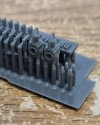
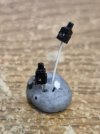
Once the paint has dried I will add the lenses. As a BR prototype, they won't be exact, but they should serve their purpose well enough!
Next up, I added some Powsides M&GN lettering and an identity to the side of the van:
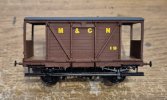
Meet M&GN No.19, built in 1898!
Unfortunately, the van is meant to have "10 TON BRAKE" two planks below the "& G" but the transfer from Powsides is too long to fit between the middle uprights. I have ordered some generic 1mm yellow lettering from Fox Transfers to allow me to represent this.
Finally, I drilled multiple holes and fitted handrails, cut/bent from 0.5mm brass wire, which were then painted white to finish them off:
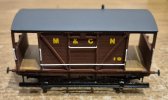
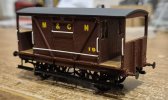
Once again, a small step or two has completely changed the look of the vehicle and i's getting very close now to being called "done"!
- James
So, starting with a minor detail, the side lamps from West Hill Wagon Works arrived and these had the handles trimmed off and the casings painted black:


Once the paint has dried I will add the lenses. As a BR prototype, they won't be exact, but they should serve their purpose well enough!
Next up, I added some Powsides M&GN lettering and an identity to the side of the van:

Meet M&GN No.19, built in 1898!
Unfortunately, the van is meant to have "10 TON BRAKE" two planks below the "& G" but the transfer from Powsides is too long to fit between the middle uprights. I have ordered some generic 1mm yellow lettering from Fox Transfers to allow me to represent this.
Finally, I drilled multiple holes and fitted handrails, cut/bent from 0.5mm brass wire, which were then painted white to finish them off:


Once again, a small step or two has completely changed the look of the vehicle and i's getting very close now to being called "done"!
- James
GWR Dia.O21
Liver & Fry
Western Thunderer
"And now for something completely different"
Earlier this past week, I went down a rabbit hole ("What? Never!" I can hear @Herb Garden exclaiming from afar).
I'm not a GWR modeller by any stretch. I had a mild affinity to them as a child (because the Little Western was by far the best bit of Sodor...) but I can't say that I've felt any need for a GW liveried wagon in the fleet. Then (and I can't recall why) I started thinking about the elusive GWR red wagon livery.
Now, I love things that are different (tune in next year for the L&Y "rainbow vans" trilogy) and so the idea of a GW wagon that wasn't grey appealed. The fact the red livery was pre-grouping appealed more. The fact Rapido produced a model of a wagon that could (in theory) prototypically carry GWR red was the icing on the cake. I quickly realised the can of worms I had opened, however, learning that no one knows for sure when it came in, when it was superseded, what the shade of red was and which bits were even painted red!
It seemed my options were as follows:
Red body, black solebar, black underframe; evidence coming from a comment here GWR early red wagon livery and a photo that I've not seen myself of a ballast wagon in 1888 that seems to show a clearly darker solebar/underframe.
Red body, red solebar and black underframe; this seems to be the version many chose to model
All over red; the suggestion being that as all over brown preceded and all over grey followed, the red era would conform to the same "all over" approach to application.
In the end I chose the latter, as the logic holds up (to me) and I like the fact it's something different. Plus, as no one can 100% prove me wrong, I can get away with it!
So, this was my donor wagon:

This is one of the later liveried examples but with single side brakes and, from what I could tell, was in the same physical condition as the early era releases by Rapido.
Existing lettering was removed:

And a coat of red was applied. I've used the same Caledonian red oxide as I used for the Highland stock and I'm quite pleased with the shade:

The false/yellow lighting in the room doesn't do it justice in photos, but you get the idea!
I have a sheet of GWR wagon lettering from Fox Transfers on standby and these will be applied in the next day or so. It's a very quick project but it was a new itch I needed to scratch! I reckon it'll add some nice variety to the fleet.
- James
Earlier this past week, I went down a rabbit hole ("What? Never!" I can hear @Herb Garden exclaiming from afar).
I'm not a GWR modeller by any stretch. I had a mild affinity to them as a child (because the Little Western was by far the best bit of Sodor...) but I can't say that I've felt any need for a GW liveried wagon in the fleet. Then (and I can't recall why) I started thinking about the elusive GWR red wagon livery.
Now, I love things that are different (tune in next year for the L&Y "rainbow vans" trilogy) and so the idea of a GW wagon that wasn't grey appealed. The fact the red livery was pre-grouping appealed more. The fact Rapido produced a model of a wagon that could (in theory) prototypically carry GWR red was the icing on the cake. I quickly realised the can of worms I had opened, however, learning that no one knows for sure when it came in, when it was superseded, what the shade of red was and which bits were even painted red!
It seemed my options were as follows:
Red body, black solebar, black underframe; evidence coming from a comment here GWR early red wagon livery and a photo that I've not seen myself of a ballast wagon in 1888 that seems to show a clearly darker solebar/underframe.
Red body, red solebar and black underframe; this seems to be the version many chose to model
All over red; the suggestion being that as all over brown preceded and all over grey followed, the red era would conform to the same "all over" approach to application.
In the end I chose the latter, as the logic holds up (to me) and I like the fact it's something different. Plus, as no one can 100% prove me wrong, I can get away with it!
So, this was my donor wagon:

This is one of the later liveried examples but with single side brakes and, from what I could tell, was in the same physical condition as the early era releases by Rapido.
Existing lettering was removed:

And a coat of red was applied. I've used the same Caledonian red oxide as I used for the Highland stock and I'm quite pleased with the shade:

The false/yellow lighting in the room doesn't do it justice in photos, but you get the idea!
I have a sheet of GWR wagon lettering from Fox Transfers on standby and these will be applied in the next day or so. It's a very quick project but it was a new itch I needed to scratch! I reckon it'll add some nice variety to the fleet.
- James
Overseer
Western Thunderer
Glad you have gone for the all over red oxide, I agree it is the most likely for several reasons, without having definite proof. The reasons for all over red include -"And now for something completely different"
Earlier this past week, I went down a rabbit hole ("What? Never!" I can hear @Herb Garden exclaiming from afar).
I'm not a GWR modeller by any stretch. I had a mild affinity to them as a child (because the Little Western was by far the best bit of Sodor...) but I can't say that I've felt any need for a GW liveried wagon in the fleet. Then (and I can't recall why) I started thinking about the elusive GWR red wagon livery.
Now, I love things that are different (tune in next year for the L&Y "rainbow vans" trilogy) and so the idea of a GW wagon that wasn't grey appealed. The fact the red livery was pre-grouping appealed more. The fact Rapido produced a model of a wagon that could (in theory) prototypically carry GWR red was the icing on the cake. I quickly realised the can of worms I had opened, however, learning that no one knows for sure when it came in, when it was superseded, what the shade of red was and which bits were even painted red!
It seemed my options were as follows:
Red body, black solebar, black underframe; evidence coming from a comment here GWR early red wagon livery and a photo that I've not seen myself of a ballast wagon in 1888 that seems to show a clearly darker solebar/underframe.
Red body, red solebar and black underframe; this seems to be the version many chose to model
All over red; the suggestion being that as all over brown preceded and all over grey followed, the red era would conform to the same "all over" approach to application.
In the end I chose the latter, as the logic holds up (to me) and I like the fact it's something different. Plus, as no one can 100% prove me wrong, I can get away with it!
So, this was my donor wagon:
View attachment 228491
This is one of the later liveried examples but with single side brakes and, from what I could tell, was in the same physical condition as the early era releases by Rapido.
Existing lettering was removed:
View attachment 228492
And a coat of red was applied. I've used the same Caledonian red oxide as I used for the Highland stock and I'm quite pleased with the shade:
View attachment 228493
The false/yellow lighting in the room doesn't do it justice in photos, but you get the idea!
I have a sheet of GWR wagon lettering from Fox Transfers on standby and these will be applied in the next day or so. It's a very quick project but it was a new itch I needed to scratch! I reckon it'll add some nice variety to the fleet.
- James
1. that many of the early GWR stock included iron bodies, the iron body was definitely red and if the red oxide was good for the body surely it is as suitable for the rest of the ironwork,
2. painting a timber body and solebar the same colour, with black Japan for ironwork makes sense but not for an iron solebar,
3. Daniel Gooch designed and oversaw the building of the rolling stock for the Geelong and Melbourne Railway during 1855, including 5 iron vans and 5 iron opens, as well as wooden opens. All were painted red oxide and the all over red oxide livery was continued by Victorian Railways from 1859 to privatisation in the 1990s (although the red colour was changed in 1954). The original drawings and specifications survive for the G&MR but unfortunately the painting specification, in Gooch's hand, is not as definitive as it could be.

[signed Dan Gooch, Paddington, April 30th 1855]
4. GWR continued the use of a single overall colour when changing the colour to grey.
5. a different colour solebar or ironwork would be visible in more photos, even with the red blindness of the negatives.
As an example of all over red rolling stock, these HO broad gauge (5'3") Victorian Railways vans are on the workbench as I am working through finishing a large backlog of shelf queens.

Liver & Fry
Western Thunderer
Mikkel and others have a thread on this subject on RMW. Might be worth a read.
Dependent on the year you’re modelling, you might want cast number plates.
atb
Simon
Their threads were part if the rabbit hole I went down. Think I've read about 6 separate threads, all very informative but equally as inconclusive!
I'm going with a 1904 date for the change to grey and so mines going to have G . W . R to the right side.
- James
GWR Dia.O21
Liver & Fry
Western Thunderer
I said it'd be a quick project!


Really glad I went with the livery variant that I did. I think the red underframe sets it off nicely and I'm certainly pleased with it now the lettering is all on. The chosen running number was that of the donor wagon, just to make life easier! As I said, this one was a curiosity and it'll add some variety to the fleet, so there was certainly no harm doing it!
- James


Really glad I went with the livery variant that I did. I think the red underframe sets it off nicely and I'm certainly pleased with it now the lettering is all on. The chosen running number was that of the donor wagon, just to make life easier! As I said, this one was a curiosity and it'll add some variety to the fleet, so there was certainly no harm doing it!
- James
Liver & Fry
Western Thunderer
Hello James
Can you tell me please, when and for how long did the GWR use this livery? Looking through the posts above it would look like before about 1902, is this right? I have never heard of it before now.
Regards
Allen
Hi Allen
In many ways this is an unanswerable question, as historical evidence is somewhat elusive.
It is generally accepted that the GWR painted their wagons red in the latter decades of the nineteenth century (although brake vans were painted grey).
Several cut off dates have been suggested, including 1896, 1898 and 1904. That said, some contemporary observers noted wagons still carrying red as late as 1914.
The 1904 date is often given as this was when the GWR changed to using the larger G W style lettering, and it is generally accepted that wagons given the larger letters were painted grey, thus the application of red had to have ended by 1904 (this is the "rule" I'm living by).
There were some variations; in 1893, the GWR changed the placement of G.W.R on the wagons from the left to the right (as per the one I've modelled), but equally in the 1890s, many wagons carried cast number plates as referenced by @simond
And thats all without going back over the unanswerable discussion about which bits were actually painted red...
It's an interesting footnote in history, but yes, the GWR did certainly have red wagons and you could get away with modelling such a wagon anytime between the end of Broad Gauge (at least) until 1904.
- James
M&GN brake van
Liver & Fry
Western Thunderer
The generic yellow transfers from Fox arrived today, meaning I could finish lettering the M&GN brake van.
The 1mm transfers fit perfectly into the space they were intended to fill. I used a capital I and O for the 10 to better match the M&GN number font and I feel this has paid off nicely.
I also fitted the lenses to the lamps and fixed these accordingly, meaning the van is now complete!




As a kit, it's taken a bit of fettling, some scratch aid work and a slice of patience, but, with the right amount of work, I feel it's produced a nice model.
I always suffer recency bias when I finish a project, but I'm really pleased with this one and, currently, it's a favourite!
- James
The 1mm transfers fit perfectly into the space they were intended to fill. I used a capital I and O for the 10 to better match the M&GN number font and I feel this has paid off nicely.
I also fitted the lenses to the lamps and fixed these accordingly, meaning the van is now complete!




As a kit, it's taken a bit of fettling, some scratch aid work and a slice of patience, but, with the right amount of work, I feel it's produced a nice model.
I always suffer recency bias when I finish a project, but I'm really pleased with this one and, currently, it's a favourite!
- James
Lyndhurstman
Western Thunderer
HelloHello James
Can you tell me please, when and for how long did the GWR use this livery? Looking through the posts above it would look like before about 1902, is this right? I have never heard of it before now.
Regards
Allen
There's a useful guide approximate dates (and the potential end of the phase) here GWR early red wagon livery. FWIW, I think it's logical that 1904 was the absolute end.
That whole site is very useful... even to non-GWR heathens like me...
Cheers
Jan
GER open wagons
Liver & Fry
Western Thunderer
It's been a while but I'm back to working on the GER opens (despite the fact Rapido have now announced these very diagrams! Oh well, the more the merrier...).
I risk setting myself up to fail here, but it's my intention to clear the workbench for a fresh start in the new year, by finishing that which I've started and getting these done by New Years Eve.
Having made up the basic bodies previously, the next task has been to start making up the underframes. Tonight's efforts have involved folding the solebar and bufferbeam etches, in a rather makeshift but effective way using a steel rule, a steel set square and a G-clamp from Hobbycraft:


It took some fettling, but all eight solebars and all eight bufferbeams are now ready to go:

There's still a fair way to go, however. Tomorrow the soldering iron comes back out and hopefully Saturday I'll have four rolling wagons!
- James
I risk setting myself up to fail here, but it's my intention to clear the workbench for a fresh start in the new year, by finishing that which I've started and getting these done by New Years Eve.
Having made up the basic bodies previously, the next task has been to start making up the underframes. Tonight's efforts have involved folding the solebar and bufferbeam etches, in a rather makeshift but effective way using a steel rule, a steel set square and a G-clamp from Hobbycraft:


It took some fettling, but all eight solebars and all eight bufferbeams are now ready to go:

There's still a fair way to go, however. Tomorrow the soldering iron comes back out and hopefully Saturday I'll have four rolling wagons!
- James
GER open wagons
Liver & Fry
Western Thunderer
Tomorrow the soldering iron comes back out and hopefully Saturday I'll have four rolling wagons!
Like clockwork...
Last night I made up the frames for the GE opens and today made up the w-iron units before attaching the lot.
First task (as per @Herb Garden 's instructions) was to attach the base plate for the w-iron unit:

Next came the frames:



And finally the w-irons themselves:


And of course, these had to be tested to make sure they'd sit/run straight and true:

I'm pleased to say they do! The wheels have since come out again to allow me to continue building work. With another stormy day looming tomorrow, I hope to make the most of the time indoors by pushing on with these.
- James
GER open wagons
Liver & Fry
Western Thunderer
Time got away from me today and I've not achieved much with the GER opens. However, I have placed an order for some springs and made a decision regarding the identities of certain wagons.
Following Rapido's recent announcement of RTR Dia.17 and Dia.48s (including the rebuilt Dia.17s), it made me question proportionality within my wagon fleet.
The GER built 12,050 Dia.17s and so you can't have too many of them. Excellent, with four available from Rapido and two provided by @Herb Garden , that makes up a healthy number to start off with. Approximately 1300 Dia.48s existed and even fewer Dia.17Rs. Rapido are offering one of each. The idea of having more than one Dia.17R seems disproportionate so what is one to do with a pair of 7 plank bodies? Well, naturally one will be built as a Dia.48. But what of the other?
Well, thankfully the GE was big on standardisation. Taking one of the 7 plank bodies, I filled in the laser cut planking for the top set of doors (on the would-be Dia.48) and then rescored the horizontal plank line, thus removing the upper doors.


This now gives me a basis for building a Dia.31 loco coal wagon, which shared the same chassis and basic proportions as the Dia.48 and had less ironwork, so it's actually an easier wagon to build!
Variety - It's the spice of life!
- James
Following Rapido's recent announcement of RTR Dia.17 and Dia.48s (including the rebuilt Dia.17s), it made me question proportionality within my wagon fleet.
The GER built 12,050 Dia.17s and so you can't have too many of them. Excellent, with four available from Rapido and two provided by @Herb Garden , that makes up a healthy number to start off with. Approximately 1300 Dia.48s existed and even fewer Dia.17Rs. Rapido are offering one of each. The idea of having more than one Dia.17R seems disproportionate so what is one to do with a pair of 7 plank bodies? Well, naturally one will be built as a Dia.48. But what of the other?
Well, thankfully the GE was big on standardisation. Taking one of the 7 plank bodies, I filled in the laser cut planking for the top set of doors (on the would-be Dia.48) and then rescored the horizontal plank line, thus removing the upper doors.


This now gives me a basis for building a Dia.31 loco coal wagon, which shared the same chassis and basic proportions as the Dia.48 and had less ironwork, so it's actually an easier wagon to build!
Variety - It's the spice of life!
- James
GER open wagons


